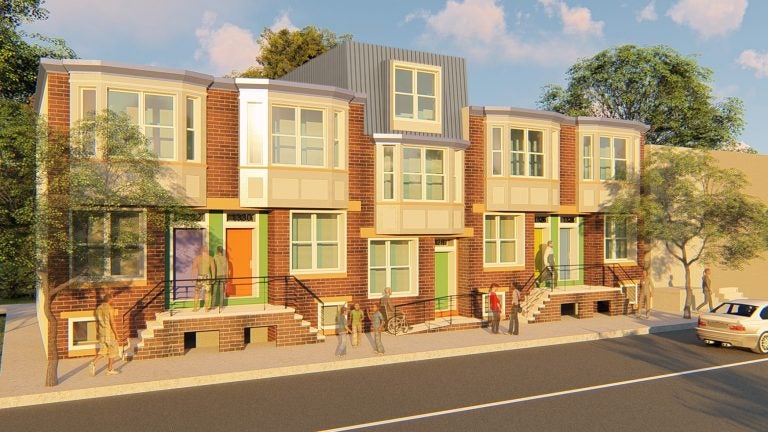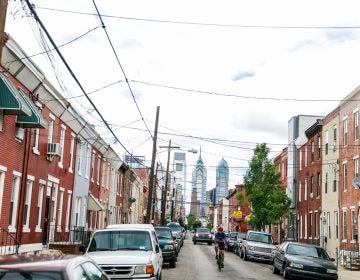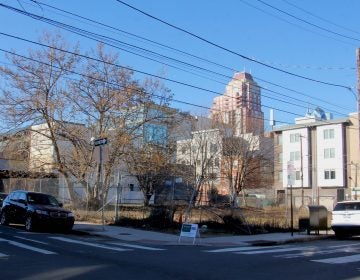Affordable forever? A new kind of housing comes to South Philadelphia
The new Mamie Nichols Homes, masterminded by the Women’s Community Revitalization Project, will be permanently affordable as part of a community land trust

Rendering of the homes from Women’s Community Revitalization Project
Rochelle Nichols-Solomon grew up in Point Breeze in a two-story brick rowhouse with her five siblings. Her mother, Mamie Nichols, was a titan of community organizing in the neighborhood.
“The changes in this area have been just astounding. It’s nutty — just look at all this,” said Nichols-Solomon, standing at the corner of Reed and Capitol streets.
Before her stood a tableau that will be familiar to anyone who’s spent time in Point Breeze over the last decade: Older two-story brick rowhomes nestled among newer three-to-four-story townhomes clad in metal panels and boxy bay windows.
Nichols-Solomon now lives in West Philadelphia, but she was back in the old neighborhood for the groundbreaking of a new collection of five townhomes. Masterminded by the Women’s Community Revitalization Project (WCRP), the new houses will be available for purchase, but they will also be permanently affordable because they will be part of a community land trust, a strategy for preserving affordability that has become increasingly popular across the country.
This little cluster of houses will be part of the Mamie Nichols Homes, dedicated to the memory of Nichols-Solomon’s mother, who fought so long and hard for a neighborhood that city leaders had all but given up on.
“She’d be proud and thrilled by the idea of permanent and affordable housing,” said Nichols-Solomon.
The WCRP worked with Councilmember Kenyatta Johnson’s office to secure the land for the Mamie Nichols Homes from the city. It will include the five permanently affordable ownership units, and 33 units of rental housing, all supported by Low Income Housing Tax Credits.
Originally, a portion of the site tract was going to be reserved for a surface parking lot, but developer Ori Feibush sued the Zoning Board of Adjustment for giving WCRP a variance for the parking lot, arguing the parking would damage the area’s walkability. The affordable developer pivoted to homeownership units instead.
The idea behind a community land trust is that the nonprofit group will hold on to the land, in WCRP’s case with a renewable 99-year ground lease. The lease guarantees that rental housing built on the property will be permanently affordable, despite expiring subsidies. For homeowners, it means they can build equity, but there will be a cap on how high the sale price can go, ensuring that when they sell, a family of a similar income and class background can buy it.
The community land trust model has existed for decades, with Bernie Sanders starting what would become the nation’s largest such organization when he was mayor of Burlington, Vermont, in the 1980s. But the Mamie Nichols Homes will be unique in Philadelphia. WCRP also runs the only other extant land trust in the city, but that one only covers rental housing.
As Philadelphia’s housing costs have increased in the neighborhoods surrounding Center City, and local politicians have become increasingly concerned about expiring affordability subsidies, the model seems to be gaining traction.
“Where land trusts have been most effective are in areas with rapidly transforming prices, and we didn’t have that in Philadelphia for a long time,” said Dina Schlossberg, a senior attorney at Regional Housing Legal Services.
But now in areas like Point Breeze, many of the neighborhood’s once-abundant vacant lots have been filled in with new market-rate houses. Newer homes regularly sell for half a million dollars or more.
The Mamie Nichols Homes will sell for $150,000. The idea is to keep a supply of homes affordable for low-to-moderate income families, even as market prices in the surrounding area shoot skyward.
“This community more than any other community in our city right now is undergoing just unbelievably rapid change. That is, unfortunately, not to the benefit of the community members,” said Anne Fadullon, director of Philadelphia’s Department of Planning and Development, at the groundbreaking for the Mamie Nichols Homes. (Fadullon is married to Nora Lichtash, the head of WCRP.)
‘Now people believe there’s a need’
While there are hundreds of community land trusts across America, many are found in smaller cities, towns, and rural areas. There are a handful of big-city success stories — like Boston’s Dudley Street Neighborhood Initiative — but in Philadelphia, the concept’s history has been far more fraught.
There were several community land trusts attempted in the 1980s and 90s in the eastern North Philadelphia neighborhoods.
The groups Kensington Joint Action Council and Manos Unidas both attempted to form community land trusts. But both organizations eventually failed. In the latter case, homeowners were stunned to learn that the defunct land trust had failed to keep up on taxes on the land below their homes, resulting in liens against their properties for taxes they didn’t even know were owed.
There were powerful skeptics as well. Schlossberg recalls talking with former Mayor John Street about the concept in the early 90s. The then-Council President told her he didn’t like the idea of limiting the equity for homeowners who would probably be African-American or Puerto Rican, while their counterparts in higher-income, usually majority white, neighborhoods would experience no such encumbrances.
But back then, home values in Philadelphia were falling, there was very little new home construction, and gentrification was not a fear that stalked lower-income neighborhoods.
“We had a lot of vacant land and we didn’t know what to do with it. We weren’t an organized city. Everyone said we were moderately priced and we didn’t have to worry about these things,” remembers Schlossberg. “Now people believe there’s a need for one [a community land trust] and I think there’s enough sophistication in the nonprofit community [to sustain such an effort].”
For a neighborhood like Point Breeze, the effort is coming late in the redevelopment process. Lichtash says the plot of land where the Mamie Nichols Homes will sit was the last publicly held vacant parcel of land in the neighborhood.
She wants to help other affordable housing developers — like HACE, Centennial Parkside CDC, and Mt. Vernon Manor CDC — launch their initiatives before reinvestment and prices surge in their backyards.
“I’m talking to 11 groups and we are talking about doing trainers with lenders, with folks in the real estate industry,” said Lichtash. “We don’t need to form a new organization, but we want to create … a server or a hub for lots of groups that are thinking about permanent affordability now, because it’s clear that displacement and gentrification are affecting more neighborhoods.”
The homeownership units that are part of the Mamie Nichols Homes are expected to be completed by the fall of 2020, while the rental units will be done by next spring.
WHYY is your source for fact-based, in-depth journalism and information. As a nonprofit organization, we rely on financial support from readers like you. Please give today.







